Gibraltar Furniture is proud to announce that it has added Driade to our collection of world class international furniture brands.
Driade was born in ’68, some decades ago, in the same period as the trends that would have characterized the twentieth century: both the rigor of geometric and rational design and , on the other hand, the recovery of pop art and its influence on pop and radical design.
Today, the “design landscape” is quite different, permeated as it is by the globalization and all- embracing digitization.To understand Driade, you should visit its headquarters in Fossadello, near Piacenza.
In this sense, the headquarters is a perfect “aesthetic laboratory” for it expresses the idea of an overall image where everything contributes to create a work of art; a Wagnerian gesamtkunstwerk, where you can find pieces of architecture, furniture, objects, fabrics and carpets and where designers, photographers, graphic designers, web designers, and workers can meet together. There’s something that reminds us of the Grand Duke Ernest Louis of Hesse who called, in 1899, the architect of the Viennese Secession Joseph Maria Olbrich to design the “Colony of artists”, Mathildenhöhe, in Darmstadt: made of buildings by Olbrich himself and, among the others, by the young Peter Behrens. It was right Behrens to give the most acute definition of Darmstadt: “celebration of life and art.”
It was meant to welcome artists, architects and designers in a place, symbol of aesthetic research, aiming at the popularization of applied arts in Germany, through the design and production of furniture and objects meant for retail.
The epoch of Mathildenhöhe was the early twentieth century, now we are in the XXI century: the age of the avant-garde, of rationalism vs. expressionism, of geometry vs. dreamy figures, has gone. The conflicts that characterized the design of the last century, if not yet disappeared, are certainly vanishing and have acquired a different sense.

This phase is marked by the multiplicity of languages that make it difficult to identify trends or relationships. A variety of authors, not always easily assessable and not all entirely acceptable, is building this century, which is characterized, in art and design, by pluralism, multiplicity of signs, and “idiolects” – as Roland Barthes called the use of language specific of a single author. The “Aesthetic laboratory” of Driade is fully relevant in this new and pluralist twenty-first century, while continuing to pursue its dream of “celebration of life and art”. Vanni Pasca
Driade is a complex project about refined aesthetics of living. In its multifaceted and eloquent catalog, Antonia Astori’s containment systems dialogue with Aleph collection furnishing: while the former organize space and constitute its skeleton, the latter isa multilingual laboratory of contemporary design.
Over the years, the catalog has displayed and promoted a rich variety of researches, poetries and international trends, portraying Driade as a constantly changing, one-of-a-kind aesthetic experiment. Today, we can clearly see what has implicitly made the difference right from the  outset: a predisposition to listening a sort of alertness and close attention to the signs coming from overseas, in order to develop those which can be translated into familiar pieces of furniture.
outset: a predisposition to listening a sort of alertness and close attention to the signs coming from overseas, in order to develop those which can be translated into familiar pieces of furniture.
The modular systems, in their abstract dimension of organizing grids, have always been a kind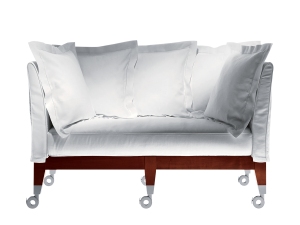
of architecture capable of absorbing and redistributing the impact of different languages. Today they have become more precious, often assuming the form of rigorous furnishing. They still guide though the flow of languages that shakes the customs of traditional living.
This permeability to differences makes the Driade project a highly up-to-date proposition, open to the future. It rejects the leveling of globalization, but senses the vitality and freshness arising from a multiplication of places where ideas are developed and products are produced.
Driade multiplies local voices, crosses borders and opens up to different influences coming from various levels of culture. The guarantee lies in high quality standards, starting from the designers’ proposals right through to production and communication.Paradoxically, the more Driade grows and evolves,accommodating diverse articulations in its catalog, the simpler it becomes clarifying and laying bare the internal paths that make it possible to create organic and coherent areas of taste. Driade’s many personalitiesare organized around a system, and each of them lives its own autonomous and complete life, which can be either orderly or unconventional, neobourgeois or revolutionarily aristocratic depending on the sensitivity and taste of whoever is choosing. Each person finds his or her own individual Driade. The extent of the tonal range, the variety of accents, and the potential to introduce dissonances that accentuate the harmony of the whole: these are the elements that differentiate Driade in the apparently elementary microcosm of living.
More than just a “brand”, Driade is thought of as a “global brand”, where the aesthetic and promotional richness is due to the character of its authors more than to the logic of a traditional business strategy. From the beginning, thus, the press communication was assigned a strategic and “evocative” role, basically on two levels: the divulgation and the promotion. Both of this functions give rise to a “metalanguage” where the “words” of individual artists are organized within a flow of communications, including publishing initiatives, slogans, events, etc. : in this way, the product’s explanation it’s told both by the story of an atmosphere and the allusion to a space where individual objects are witnesses and guarantors.
In this case too, you have to look behind effects to find people: Adelaide Astori, who interpreted emphatically the concept of production as collection with her unitary and continuous press direction, imagined a “second life” where objects and f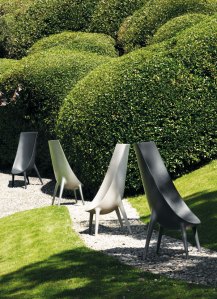 furnishings were more real than in reality.
furnishings were more real than in reality.
As Italo Lupi wrote, Adelaide Astori has been able to “imagine the photo shoot as a true product of the dramatic technique”: the “houses” of Driade arise, in fact, from the most “precious” room in the factory of Fossadello, the white room, where things are arranged as an idealized vision, that becomes tangible and concrete though the photographed image.
Communication, therefore, is not only the natural vehicle for the transmission of data: its “virtual” nature acquire, in fact, a structural value which is one with the eclecticism of the catalog : it’s a catalog itself, or rather a container where the artists’ idiosyncrasies and the producers’ individuality are combined into a single image. Virtual and real at the same time.
Fulvio Irace.
“Beauty factory”, “agency-enterprise”, “creative laboratory” … Many definitions have tried, over time, to define the atypical image of Driade in the landscape of international design. Each of them depict a part of reality, but none describes it all. Behind every company, there are indeed individuals, charisma, intuition and dedication of a unique character that finds, in the outline of work, the most suitable soil for the completion of its personality.
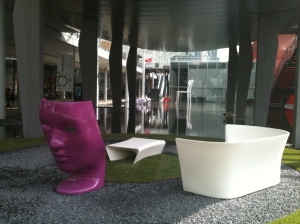
How could you possibly think about “Wiener Werkstätten” without Joseph Hoffmann, Omega Workshops without the extravagant members of the exclusive Bloomsbury group, Memphis without Ettore Sottsass or Alchymia without Alessandro Mendini? Similarly, in 1968, Driade would have never been born if a young graduate in architecture hadn’t decided to turn his back to the family business – a solid enterprise of concrete prefabricated – to give shape to a dream very close to an obsession. Producing furniture and furnishings not as “types” – that is, elements of an infinite assembly line- but as individual art objects; to become, therefore, not an entrepreneur, but an art collector. The obsession becomes production, but its rules are not those of the market, but those of many individual choices. Enrico Astori has repeatedly stated that he would have never been able to produce things that wouldn’t have liked to give friends or keep at home: it may seem incredible (or naive) to trade analysts but, this is how Driade was developed as a factory of art. It is so that its greedy, irreducible diversity of creative enterprise, focusing on the language of authors, artists and designers, was developed and spread.
The strategy of the collector becomes the company’s strategy: the brand is focused on the essence of experimentation and dissemination. Driade collections, in almost half a century, have become something like a logical labyrinth, where everything finds its natural place and talks to us of an endless time when collections, themselves, perpetuate as a family legacy. That’s why Elisa Astori has become, since a while, the mistress of a house that needs to be always updated and enriched of the idiosyncrasies and ambitions of the heirs, to remain vital and constantly open to the world.





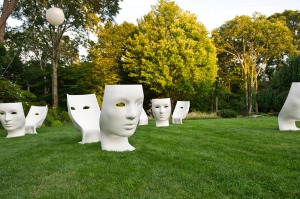
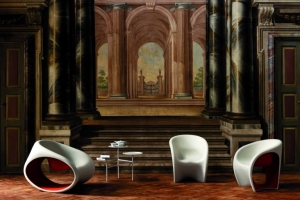
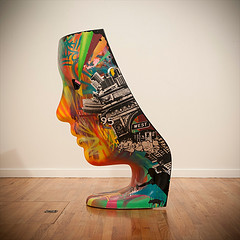
You must be logged in to post a comment.